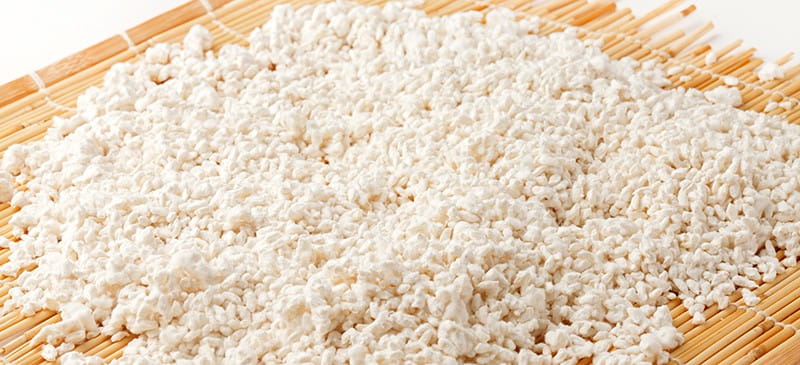Exploring the Magic of Koji
There’s been a lot of buzz about fermented foods like kombucha, kimchi and kefir lately. But have you heard of koji?
Once considered exclusive to Japanese cuisine, more and more chefs around the globe are starting to experiment with koji, a type of fungus that can totally transform the taste and texture of many dishes.
So what exactly is it, how is it used and is it actually good for you? Keep reading for everything you need to know about this beneficial form of fungus and how you can add it to your diet.

What Is Koji?
Koji is a traditional Japanese ingredient used to enhance the flavor of many common dishes. Also known as Aspergillus oryzae, this uncommon ingredient is actually a type of fungus used in the process of fermentation.
Rice koji, or koji rice, is made of cooked rice that has been cultured with Aspergillus oryzae. During the fermentation process, the fungus releases specific enzymes that help break down the carbohydrates and proteins, ramping up the content of probiotics and giving it a unique, one-of-a-kind flavor.
What does koji taste like? Although many may be put off by the concept of adding fungus to rice, koji rice is completely edible and full of flavor.
It tends to have a slightly nutty, floral scent. Many people describe it as a blend of sweet, salty and savory.
Types
Besides rice, this popular form of fungus can be found in many different foods and ingredients, many of which may already be sitting on your shelves.
In fact, koji can be used to ferment other grains and legumes to make barley, soybean or corn koji. It’s also used to make staple ingredients like koji sake, miso, tamari and soy sauce.
Shio koji is another popular all-purpose seasoning made from koji rice, sea salt and water. You can use it as a salt substitute or to marinate meat or veggies.
It’s also sometimes cultured with other ingredients to help enhance the flavor, such as koji butter.
Is Koji Healthy?
Like other fermented foods, it possesses a number of powerful health benefits.
In particular, it acts as a great source of probiotics, a type of beneficial bacteria that helps improve gut health and enhance nutrient absorption.
Probiotics have also been associated with a number of other benefits as well. In fact, some research suggests probiotics could impact immune function, cholesterol levels, heart health and mood.
Many foods made from the fungus also contain a number of essential nutrients, including important vitamins and minerals.
Miso, for example, functions as a great source of vitamin K, manganese, copper and zinc. Miso has also been shown to reduce blood pressure levels and improve blood sugar control, according to some animal studies.
Keep in mind, however, that many foods made with koji contain high amounts of sodium, including miso, soy sauce and tamari. For best results, enjoy these foods in moderation along with an assortment of other healthy whole foods to keep your sodium intake in check.
How to Use and Grow
Plenty of options exist for purchasing koji, including many specialty stores and online retailers. However, you can easily make it at home, using just a few simple ingredients.
So how do you grow koji? To get started, you need to select a substrate for the fungus, such as rice, barley or soybeans.
The fungus needs warmth and humidity to help it grow. Using a koji incubator can be an especially useful strategy.
You can also use hot water bottles and towels, humidifiers or baking trays with warm water to help promote its growth.
The spores should be spread over your grains using a sieve and then maintained at the appropriate temperature and humidity level for at least 24 hours. Depending on the type of grain you are using, it should be ready within 40–50 hours, just before it begins to produce spores.
In other words, don’t eat it if your food has turned green. It’s fermented far too long.
You can use the finished product in a number of different recipes, as either a natural seasoning or flavor-enhancer.
You can use it to make soy sauce, miso, sake and tamari. More recently, koji protein dog treats have even popped up in specialty shops. You can also use it as a dry rub to help tenderize meat, creating a naturally-aged koji steak or koji charcuterie.
Conclusion
- Often found in Japanese cuisine, shiragiku koji is a type of fungus that is used to ferment grains and legumes like rice, barley and soybeans.
- It’s used to make many other ingredients, including miso, soy sauce, tamari and sake. It’s also used to marinate meat or veggies and make shio koji, a popular all-purpose seasoning and salt substitute.
- Because it’s fermented, it may be linked to several health benefits, including improved gut health, immune function, heart health and mood.
- Many foods made using this healthy form of fungus are also rich in vitamins and minerals, plus linked to other health benefits as well.
- Best of all, it’s easy to make at home and incredibly versatile, making it a great addition to any kitchen.





Leave a comment